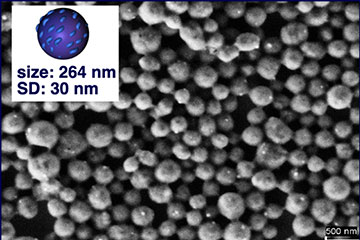
Shaping the future of polymer nanocarriers [Image: Félix Freire – CiQUS]
Nanocarriers—nanostructures that can transport another substance—have shown promise for targeted drug delivery, especially in cancer therapy. By delivering the drug directly to affected tissue, they have the ability to optimize efficiency and reduce undesirable side effects.
Now, researchers at the Center for Research in Biological Chemistry and Molecular Materials (CiQUS), Spain, have created customizable polymer nanospheres that release their encapsulated contents upon irradiation with light (Angew. Chem. Int. Ed., doi: 10.1002/anie.202403313). The size of the nanospheres, which affects their biodistribution and elimination, is readily controlled by adjusting the water-to-solvent ratio during their preparation, making them applicable to a wide range of tissues.
The influence of structure
Nanoprecipitation is a spontaneous emulsification process commonly used to encapsulate active drugs or other substances with polymers. Typically, a hydrophobic polymer is dissolved in a solvent such as ethanol or acetone. After mixing with water, the phase separation of the polymer from the solution results in the formation of nanoparticles. The technique has the advantages of being simple, reproducible and energy-efficient.
Previous work has demonstrated the self-assembly of dynamic helical polymers into chiral nanospheres through nanoprecipitation. The current study uncovers how the structure of helical polymers influences their self-assembly into nanospheres, a relationship that had not yet been explored. The researchers employed a nanoprecipitation approach for a library of poly(phenylacetylene)s (PPAs) with different molecular structures.
The results revealed that PPAs with dynamic and flexible scaffolds generated low polydisperse nanospheres with controllable size at different acetone-to-water ratios. On the other hand, PPAs with an extended, almost planar structure aggregated into spherical and oval nanostructures whose sizes could not be controlled.
The results revealed that PPAs with dynamic and flexible scaffolds generated low polydisperse nanospheres with controllable size at different acetone-to-water ratios.
Released by light
Next, the researchers studied the encapsulation ability and light-triggered release of the nanospheres. Nanospheres with a diameter of 400 nm were prepared in an acetone/water mixture in the presence of either fluorescent dyes or quantum dots. Confocal microscopy visualized the nanospheres with the contents trapped inside.
More than an hour of irradiation with UV/visible light destroyed the polymer particles by photochemical electrocyclization of the polyene backbones, releasing the encapsulated material. The rate of this process also depends on the structure of the helical polymer. For example, stretched helices exhibited slower photodegradation compared to more compact helices, which could allow for a precisely controlled rate of release.
